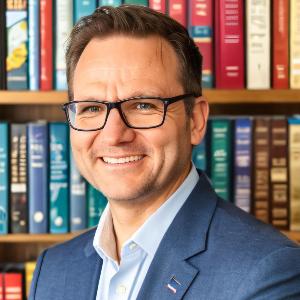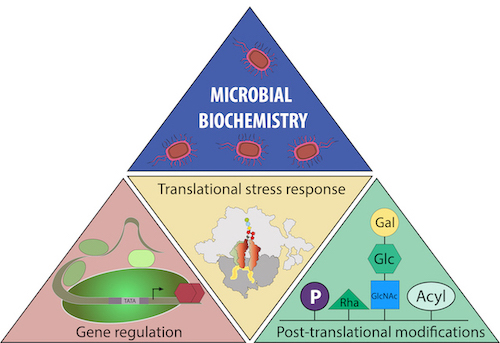Gene regulation
My research centers on non-canonical amino acids and their fundamental roles in biological systems. Specifically, we focus on chemically modified amino acids arising from processes such as the Maillard reaction, including early-stage products (fructosyllysine) and advanced glycation end products (AGEs) like carboxymethyllysine (CML), which accumulate both in human proteins during aging and through food processing. We investigate how these amino acids act as signaling molecules affecting gene regulation, how microorganisms recognize them, and how they enzymatically metabolize and degrade them. Additionally, we explore how non-canonical amino acids serve as posttranslational modifications, emphasizing novel glycosylations and previously unknown chemical modifications of proteins that can profoundly influence biological functions. Another central aspect of our research is translational control, specifically employing specialized translation factors such as EF-P to incorporate non-canonical amino acids into proteins. This allows for genetic code expansion, enabling the production of proteins with novel properties, such as antimicrobial activity and increased stability. To comprehensively address these questions, we integrate methodologies from genetics, proteomics, structural biology, and synthetic biology.
2024
1. Sieber A, Parr M, von Ehr J, Dhamotharan K, Kielkowski P, Brewer T, Schäpers A, Krafczyk R, Qi F, Schlundt A, Frishman D & Lassak J+: EF-P and its paralog EfpL (YeiP) differentially control translation of proline-containing sequences. Nat. Commun.
2. Lassak J+ & Tschowri N: Editorial overview: Linking cellular regulation and metabolic functions: from signals to mechanisms. Curr. Opin. Microbiol.
3. Lassak J+: Arbeitskreis GBM Young Investigator - Zweiter Online-Workshop „Developing my research brand“ Biospektrum
4. Lassak J+: Biospektrum Journal Club: Wie Bakterien durch reverse Transkription Viren in die Schranken weisen. Biospektrum
2023
1. Lassak J+, Aveta E, Vougioukas P, Hellwig M+: Non-canonical food sources: Bacterial metabolism of Maillard reaction products and its regulation. Curr. Opin. Microbiol.b
2. Lassak J+ & Schlundt A: Arbeitskreis GBM Young Investigator - Erster Online-Workshop „Forschungsförderung strategisch nutzen“ Biospektrum
3. Lassak J+: Biospektrum Journal Club: Genetische Doppeldeutigkeit am Ribosom. Biospektrum
4. Lassak J+ & Commichau F: VAAM-Fachgruppe Regulation - Zweites digitales Lunch-Meeting Biospektrum
5. Lassak J+ & Commichau F: VAAM-Fachgruppe Regulation - Über den genetischen Code hinaus: Posttranslationale Modifikationen in Mikroorganismen
2022
1. Mehler J, Behringer KI, Rollins R, Piesarz F, Klingl A, Henle T, Heerman R, Becker N, Hellwig M+, Lassak J+: Identification of Pseudomonas asiatica subsp. bavariensis str. JM1 as the first Nε-carboxy(m)ethyllysine degrading soil bacterium. Environ. Microbiol.a
2. Lassak J+: Biospektrum Journal Club: Ribosomenkollision aktiviert molekulare Pannenhilfe in Bakterien. Biospektrum
3. Lassak J+, Sieber A, Hellwig M+: Exceptionally versatile take II: Post-translational modifications of lysine and their impact on bacterial physiology. Biol. Chem.b
4. Weigand J+ & Lassak J+: Zwischen Postdoc und Professur – Der GBM Arbeitskreis Young Investigators.Biospektrum
5. Bischofs I+ & Lassak J+: Herbstschule zur Regulation und Signaltransduktion in Prokaryoten (RSTiP). Biospektrum
2021
1. Lassak J+: Biospektrum aktuell: Der mikrobielle Fingerabdruck unserer Städte. Biospektrum
2. Lassak J+: Biospektrum Journal Club: Kleine nicht-codierende RNAs mit Zuckerdekor. Biospektrum
3. Bischofs I* & Lassak J*: Bericht zum Symposium der VAAM-Fachgruppe Regulation und Signaltransduktion in Prokaryoten: Grenzenlose Wahrnehmung. Biospektrum
4. Koller F, Lassak J+: Two RmlC paralogs catalyse dTDP-4-keto-6-deoxy-D-glucose epimerization in Pseudomonas putida KT2440. Sci. Rep.a
5. Krafczyk R*, Fei Q*, Sieber A, Mehler J, Jung K, Frishman D+, Lassak J+: Proline codon pair selection determines ribosome pausing strength and translation efficiency in bacteria. Comm. Biol.a
6. Graf von Armansperg B*, Koller F*, Gericke N*, Hellwig M, Jagtap PKA, Heermann R, Hennig J, Henle T & Lassak J+: Transcriptional regulation of the Nε-fructoselysine metabolism in Escherichia coli by global and substrate-specific cues. Mol. Microbiol.a
7. Pfab M, Kielkowski P, Krafczyk R, Volkwein W, Sieber SA, Lassak J & Jung K: Synthetic post-translational modifications of elongation factor P using the ligase EpmA. FEBS J.a
8. Yakovlieva L, Wood TM, Kemmink J, Kotsogianni I, Koller F, Lassak J, Martin NI, Walvoort MTC: β-hairpin epitope as novel structural requirement for protein arginine rhamnosylation. Chem. Sci.a
2020
1. Gast D*, Koller F*, Krafczyk R, Bauer L, Wunder S, Lassak J+ & Hoffmann-Röder A: A set of rhamnosylation-specific antibodies enables detection of novel protein glycosylations in bacteria. Org. Biomol. Chem.a
2. Brameyer S*, Hoyer E*, Bibinger S, Burdack K, Lassak J & Jung K: Molecular design of a signaling system influences gene expression noise under acid stress in different γ-proteobacteria. J. Bacteriol.b
3. Lassak J+: Biospektrum Journal Club: Selektive Translation reloaded: alternative Ribosomen in Mykobakterien. Biospektrum
4. Commichau F* & Lassak J*: Bericht zum Symposium der VAAM-Fachgruppe Regulation und Signaltransduktion in Prokaryoten: Moonlighting-Proteine und promiskuitive Enzyme. Biospektrum
5. Lassak J+: Biospektrum aktuell: Bakterienzähmen leicht gemacht – durch eine gesunde menschliche Schleimhaut. Biospektrum
6. Lassak J+, Schlundt A+, Feige M+ & Hennig J+: Zusammenarbeit zur Förderung des wissenschaftlichen Nachwuchses in Deutschland - Die GBM Young Investigators und Biological Chemistry (DeGruyter). Biospektrum
2019
1. Volkwein, W*, Krafczyk R*, Jagtap PKA, Parr M, Mankina E, Macosek J, Guo Z, Fürst M, Pfab M, Frishman D, HennigJ, Jung K & Lassak J+: Switching the post-translational modification of translation elongation factor EF-P.Front. Microbiol.a
2. Lassak, J+, Koller F, Krafczyk R & Volkwein W: Exceptionally versatile - arginine in bacterial post-translational protein modifications. Biol. Chem.b
3. Lassak J+: Biospektrum Journal Club: Gleich und doch anders – selektive Translation durch heterogene Ribosomen. Biospektrum
2018
1. Fei Q, Motz M, Jung K, Lassak J, Frishman D: Evolutionary analysis of polyproline motifs in Escherichia coli reveals their regulatory role in translation. PloS Comput. Biol.a
2. Jung K, Fabiani, F, Hoyer E, Lassak J: Bacterial transmembrane signalling systems and their engineering for biosensing. Open Biol. b
3. Jung K, Fabiani, F, Hoyer E, Lassak J: Von der Entschlüsselung der Designprinzipien des Lebens zum Design von synthetischen biomolekularen Systemen. Broschüre zur 7. Fachtagung Gentechnik "Synthetische Biologie"
4. Lassak J+: La dolce vita — Süße Übersetzungshilfe für Prolinfolgen. Biospektrum
5. Lassak J+: What a bacterial translation elongation factor teaches us about glycosylation. GRK2062 Newsletter
Habilitation: Lassak J: Zur Molekularen Funktion und Posttranslationalen Aktivierung des Bakteriellen Translationselongationsfaktors EF-P
2017
1. Krafczyk R*, Macošek J*, Jagtap PKA, Gast D, Wunder S, Mitra P, Jha AK, Rohr J, Hoffmann-Röder A, Jung K, Hennig J*+, Lassak J*+: Structural basis for EarP-mediated arginine glycosylation of translation elongation factor EF-P. mBioa
2. Lassak J+: The sweet sites of bacteria. GRK2062 Newsletter
3. Schlundt A, Buchner S, Janowski R, Heydenreich T, Heermann R, Lassak J, Geerlof A, Stehle R, Niessing D, Jung K, Sattler M: Structure-function analysis of the DNA-binding domain of a transmembrane transcriptional activator. Sci. Rep.a
4. Volkwein W, Maier C, Krafczyk R, Jung K+, Lassak J+: A versatile toolbox for the control of protein levels using Nε‑acetyl‑L‑lysine dependent amber suppression. ACS Synth. Biol.a
2016
1. Lassak J+, Jung K+: Don’t stop me now! - Die Rolle des Elongationsfaktors P (EF-P) bei der Translation von Polyprolinsequenzen. labor&more
2. Lassak J, Wilson DN, Jung K: Stall no more at polyproline stretches with translation elongation factors EF-P and IF-5A. Mol. Microbiol.b
3. Li, X*, Krafczyk R*, Macoşek J, Li Y-W, Zou Y, Simon B, Pan X, Wu Q-Y, Yan F, Li S, Hennig J, Jung K, Lassak J+, Hu H-G+: Resolving the α-glycosidic linkage of arginine-rhamnosylated translation elongation factor P (EF-P) triggers generation of the first ArgRha specific antibody. Chem. Sci.a
4. Lorenz, N, Reiger M, Toro-Nahuelpan M, Brachmann A, Poettinger L, Plener L, Lassak J, Jung K, Identification and initial characterization of prophages in Vibrio campbellii. PloS one a
2015
1. Buchner S, Schlundt A, Lassak J, Sattler M, Jung K: Structural and functional analysis of the signal transducing linker in the pH-responsive one component system CadC of Escherichia coli. J. Mol. Biol. a
2. Lassak J+, Keilhauer EK, Fürst M, Wuichet K, Gödeke J, Starosta AL, Chen J, Sogaard-Andersen L, Rohr J, Wilson DN, Jung K: Arginine-rhamnosylation as new strategy to activate translation elongation factor P. Nat. Chem. Biol.a
3. Reiger M*, Lassak J*, Jung K: Deciphering the role of the type II glyoxalase isoenzyme YcbL (GlxII-2) in Escherichia coli. FEMS Microbiol. Lett.a
2014
1. Lassak J, Fried L, Jung K: Angestaubt aber nicht eingerostet – der Bioreporter LacZ. Biospektrum
2. Starosta AL, Lassak J, Jung K, Wilson DN: The bacterial translation stress response. FEMS Microbiol. Rev. b
3. Starosta AL, Lassak J, Peil L, Atkinson GC, Virumae K, Tenson T, Remme J, Jung K, Wilson DN: Translational stalling at polyproline stretches is modulated by the sequence context upstream of the stall site. Nucleic Acids Res.a
4. Starosta AL, Lassak J, Peil L, Atkinson GC, Woolstenhulme CJ, Virumae K, Buskirk A, Tenson T, Remme J, Jung K, Wilson, DN: A conserved proline triplet in Val-tRNA synthetase and the origin of elongation factor P. Cell Rep.a
2013
1. Lassak J+, Bubendorfer S, Thormann KM+: Domain analysis of ArcS, the hybrid sensor kinase of the Shewanella oneidensis MR-1 Arc two-component system, reveals functional differentiation of its two receiver domains. J. Bacteriol. (content of PhD thesis)a
2. Lassak J, Ude S, Starosta AL, Wilson DN, Jung K: Translation von Polyprolin-Proteinen. Biospektrum
3. Peil L, Starosta AL, Lassak J, Atkinson GC, Virumae K, Spitzer M, Tenson T, Jung K, Remme J, Wilson DN: Distinct X/PP/X sequence motifs induce ribosome stalling, which is rescued by the translation elongation factor EF-P.Proc. Natl. Acad. Sci. USAa
4. Ude S*, Lassak J*, Starosta AL, Kraxenberger T, Wilson DN, Jung K: Translation elongation factor EF-P alleviates ribosome stalling at polyproline stretches. Science a
2012
1. Fried L*, Lassak J*, Jung K: A comprehensive toolbox for the rapid construction of lacZ fusion reporters. J. Microbiol. Methods a
2011
1. Binnenkade L*, Lassak J*, Thormann KM: Analysis of the BarA/UvrY two-component system in Shewanella oneidensis MR-1. PloS one (content of PhD thesis) a
2. Gödeke J, Paul K, Lassak J, Thormann KM: Phage-induced lysis enhances biofilm formation in Shewanella oneidensis MR-1. ISME J. a
2010
1. Krügel H, Licht A, Biedermann G, Petzold A, Lassak J, Hupfer Y, Schlott B, Hertweck C, Platzer M, Brantl S et al: Cervimycin C resistance in Bacillus subtilis is due to a promoter up-mutation and increased mRNA stability of the constitutive ABC-transporter gene bmrA. FEMS Microbiol. Lett.a
2. Lassak J, Henche AL, Binnenkade L, Thormann KM: ArcS, the cognate sensor kinase in an atypical Arc system of Shewanella oneidensis MR-1. Appl. Environ. Microbiol. (content of PhD thesis)a
Dissertation: Lassak J: Evolution von Zwei-Komponenten-Systemen in Shewanella oneidensis MR-1. Die Histidinkinase ArcS und der Antwortregulator SO_4444,Zwei Komponenten, Zwei Modelle.
2009
1. Paulick A, Koerdt A, Lassak J, Huntley S, Wilms I, Narberhaus F, Thormann KM: Two different stator systems drive a single polar flagellum in Shewanella oneidensis MR-1. Mol. Microbiol.
* equal contribution
+ correspondence
a original work with new scientific results peer reviewed
b Reviews peer reviewed
grey: reviews, reports, editorials not peer reviewed
Postdoc applicants should be willing to apply for funding (see list of fellowships below).


